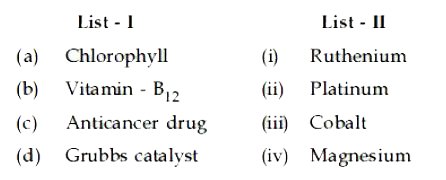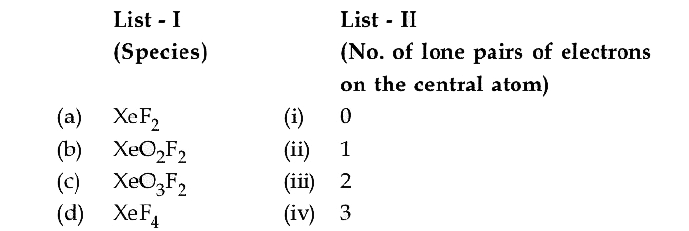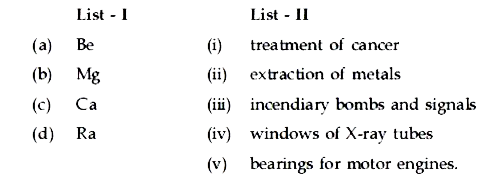Assertion A : Sharp glass edge becomes smooth on heating it upto its melting point.
Reason R : The viscosity of glass decreases on melting.
Choose the most appropriate answer from the options given below.
A is true but R is false
Both A and R are true but R is NOT the correct explanation of A.
A is false but R is true.
Both A and R are true and R is the correct explanation of A.
To solve the given assertion and reason question, we will analyze both the assertion (A) and the reason (R) step by step.
Step 1: Analyze the Assertion (A)
Assertion A: Sharp glass edge becomes smooth on heating it up to its melting point.
- When glass is heated to its melting point, it transitions from a solid state to a liquid state.
- In the liquid state, the glass molecules gain enough energy to move freely, allowing the sharp edges to round off.
- This is due to the tendency of liquids to minimize their surface area. The sharp edges will smooth out as the glass melts.
Conclusion for A: The assertion is true.
Step 2: Analyze the Reason (R)
Reason R: The viscosity of glass decreases on melting.
- Viscosity is a measure of a fluid's resistance to flow. When glass is heated and melts, its viscosity indeed decreases.
- As temperature increases, the molecular motion increases, leading to a decrease in viscosity. This means that the glass becomes less resistant to flow when it is melted.
Conclusion for R: The reason is also true.
Step 3: Determine the Relationship Between A and R
Now, we need to determine if the reason (R) correctly explains the assertion (A).
- While both the assertion and reason are true, the reason does not directly explain why the sharp edges become smooth. The smoothing occurs because the glass transitions to a liquid state and seeks to minimize surface area, not solely because of the decrease in viscosity.
Final Conclusion
- Both A and R are true, but R is not the correct explanation of A.
Answer
The correct option is B: Both A and R are true, but R is not the correct explanation of A.
---
Assertion A: Sharp glass edge becomes smooth on heating it up to its melting point.
- In the liquid state, the glass molecules gain enough energy to move freely, allowing the sharp edges to round off.
- This is due to the tendency of liquids to minimize their surface area. The sharp edges will smooth out as the glass melts.
Reason R: The viscosity of glass decreases on melting.
- As temperature increases, the molecular motion increases, leading to a decrease in viscosity. This means that the glass becomes less resistant to flow when it is melted.
Now, we need to determine if the reason (R) correctly explains the assertion (A).
- Both A and R are true, but R is not the correct explanation of A.
The correct option is B: Both A and R are true, but R is not the correct explanation of A.
Topper's Solved these Questions
- JEE MAINS 2021BOOK - JEE MAINS PREVIOUS YEARCHAPTER - JEE MAINS 2021EXERCISE - CHEMISTRY (SECTION-B)
10 Videos
- JEE MAINS 2021BOOK - JEE MAINS PREVIOUS YEARCHAPTER - JEE MAINS 2021EXERCISE - CHEMISRY (SECTION-A)
21 Videos
- JEE MAINS 2020BOOK - JEE MAINS PREVIOUS YEARCHAPTER - JEE MAINS 2020EXERCISE - CHEMSITRY
25 Videos
- JEE MAINS 2022BOOK - JEE MAINS PREVIOUS YEARCHAPTER - JEE MAINS 2022EXERCISE - CHEMISTRY (SECTION-B)
10 Videos
Similar Questions
Knowledge Check
Match List - I with List- II

Choose the most appropriate answer from the options given below -A(a)→(i),(b)→(iii),(c)→(iv),(d)→(ii)B(a)→(ii),(b)→(i),(c)→(iv),(d)→(iii)C(a)→(ii),(b)→(iv),(c)→(i),(d)→(iii)D(a)→(iii),(b)→(i),(c)→(ii),(d)→(iv)Match List - I with List- II

Choose the most appropriate answer from the options given below -A(a)→(ii),(b)→(iii),(c)→(iv),(d)→(i)B(a)→(i),(b)→(iv),(c)→(iii),(d)→(ii)C(a)→(i),(b)→(iii),(c)→(iv),(d)→(ii)D(a)→(iv),(b)→(i),(c)→(ii),(d)→(iii)
Match List - I with List -II

Choose the most appropriate answer from the options given below :
View SolutionMatch List - I with List - II

Choose the most appropriate answer from the options given below :
View SolutionMatch List-I with List-II :

Choose the most appropriate answer from the options given below :
View SolutionMatch List-I with List-II :

Choose the most appropriate answer from the options given below :
View SolutionMatch List -I with List-II :

Choose the most appropriate answer from the option given below:
View SolutionMatch List -I with List -II :

Choose the most appropriate answer from the options given below :
View Solution


